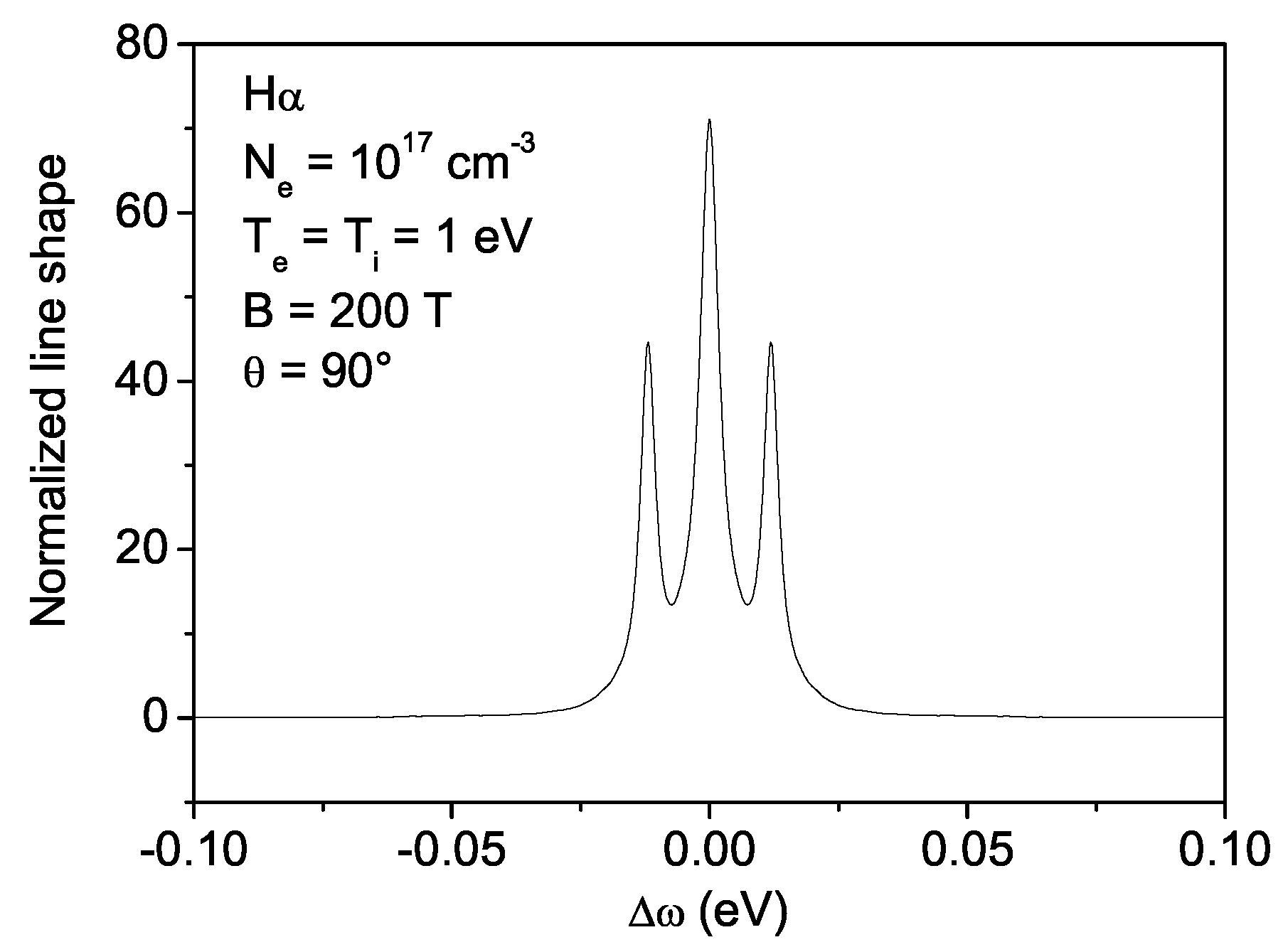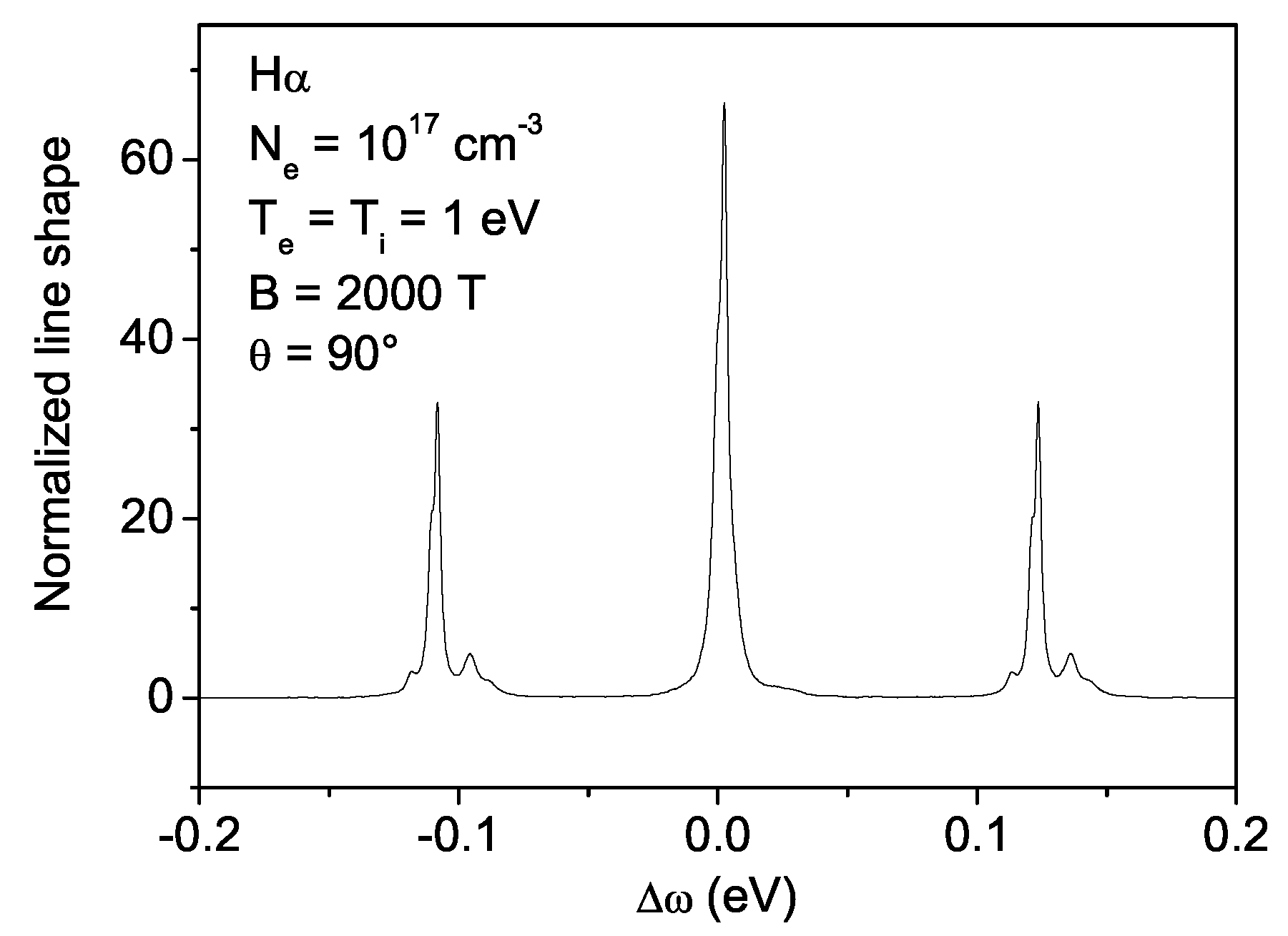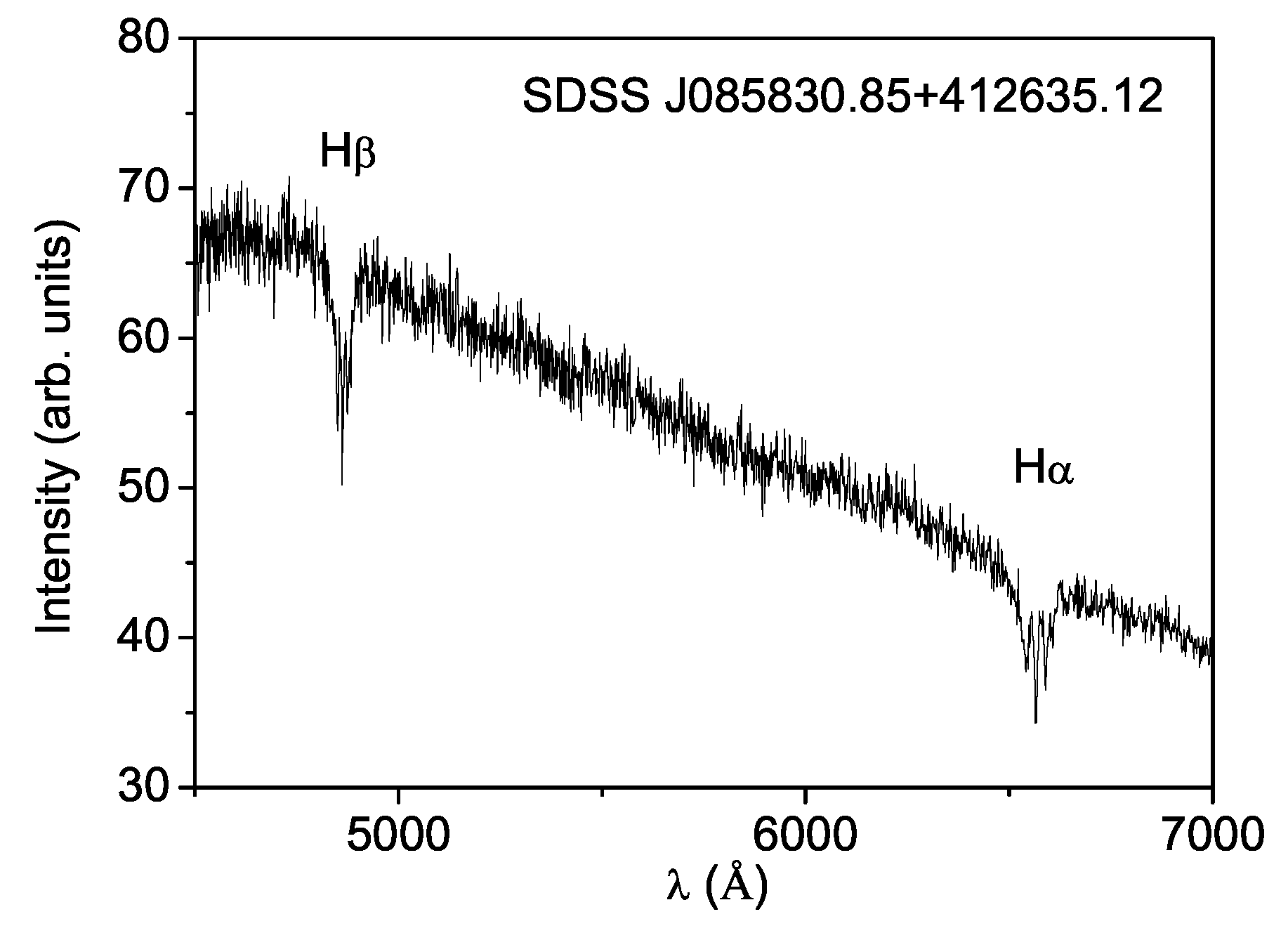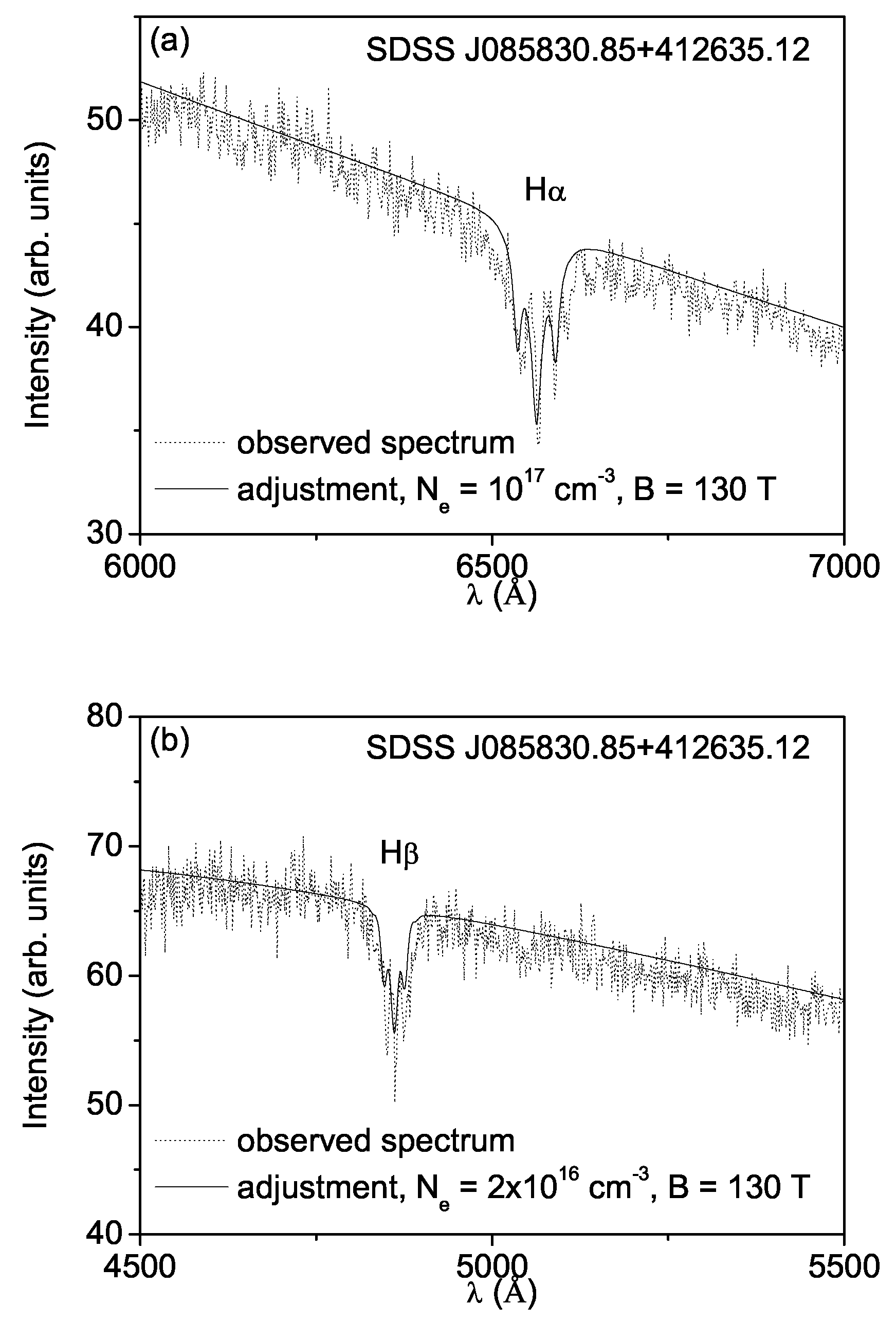A New Analysis of Stark and Zeeman Effects on Hydrogen Lines in Magnetized DA White Dwarfs
Abstract
:1. Introduction
2. Stark Line Shape Modeling
3. Zeeman Effect in Magnetized White Dwarfs
4. White Dwarf Spectrum Analysis
5. Conclusions
Acknowledgments
Author Contributions
Conflicts of Interest
References
- Külebi, B.; Jordan, S.; Euchner, F.; Gänsicke, B.T.; Hirsch, H. Analysis of hydrogen-rich magnetic white dwarfs detected in the Sloan Digital Sky Survey. Astron. Astrophys. 2009, 506, 1341–1350. [Google Scholar] [CrossRef]
- Schmidt, G.D.; Harris, H.C.; Liebert, J.; Eisenstein, D.J.; Anderson, S.F.; Brinkmann, J.; Hall, P.B.; Harvanek, M.; Hawley, S.; Kleinman, S.J.; et al. Magnetic White Dwarfs from the Sloan Digital Sky Survey: The First Data Release. Astrophys. J. 2003, 595, 1101. [Google Scholar] [CrossRef]
- Vanlandingham, K.M.; Schmidt, G.D.; Eisenstein, D.J.; Harris, H.C.; Anderson, S.F.; Hall, P.B.; Liebert, J.; Schneider, D.P.; Silvestri, N.M.; Stinson, G.S.; et al. Magnetic White Dwarfs from the SDSS II. The Second and Third Data Releases. Astron. J. 2005, 130, 734–741. [Google Scholar] [CrossRef]
- Kepler, S.O.; Pelisoli, I.; Jordan, S.; Kleinman, S.J.; Kulebi, B.; Koester, D.; Peçanha, V.; Castanheira, B.G.; Nitta, A.; da Silveira Costa, J.E.; et al. Magnetic white dwarf stars in the Sloan Digital Sky Survey. Mon. Not. R. Astron. Soc. 2013, 429, 2934–2944. [Google Scholar] [CrossRef]
- Fontaine, G.; Michaud, G. Diffusion time scales in white dwarfs. Astrophys. J. 1979, 231, 826–840. [Google Scholar] [CrossRef]
- Rohrmann, R.D. Hydrogen-model atmospheres for white dwarf stars. Mon. Not. R. Astron. Soc. 2001, 323, 699–712. [Google Scholar] [CrossRef] [Green Version]
- Rosato, J.; Kieu, N.; Hannachi, I.; Koubiti, M.; Marandet, Y.; Stamm, R.; Dimitrijević, M.S.; Simić, Z. Stark-Zeeman Line Shape Modeling for Magnetic White Dwarf and Tokamak Edge Plasmas: Common Challenges. Atoms 2017, 5, 36. [Google Scholar] [CrossRef]
- Rosato, J.; Marandet, Y.; Capes, H.; Ferri, S.; Mossé, C.; Godbert-Mouret, L.; Koubiti, M.; Stamm, R. Stark broadening of hydrogen lines in low-density magnetized plasmas. Phys. Rev. E 2009, 79, 46408. [Google Scholar] [CrossRef] [PubMed]
- Griem, H.R. Principles of Plasma Spectroscopy; Cambridge University Press: Cambridge, UK, 1997. [Google Scholar]
- Brissaud, A.; Frisch, U. Theory of Stark broadening—II exact line profile with model microfield. J. Quant. Spectrosc. Radiat. Transf. 1971, 11, 1767–1783. [Google Scholar] [CrossRef]
- Stehlé, C.; Hutcheon, R. Extensive tabulations of Stark broadened hydrogen line profiles. Astron. Astrophys. Suppl. Ser. 1999, 140, 93–97. [Google Scholar] [CrossRef]
- Calisti, A.; Mossé, C.; Ferri, S.; Talin, B.; Rosmej, F.; Bureyeva, L.A.; Lisitsa, V.S. Dynamic Stark broadening as the Dicke narrowing effect. Phys. Rev. E 2010, 81, 16406. [Google Scholar] [CrossRef] [PubMed]
- Stambulchik, E.; Maron, Y. Quasicontiguous frequency-fluctuation model for calculation of hydroge. Phys. Rev. E 2013, 87, 53108. [Google Scholar] [CrossRef] [PubMed]
- Stamm, R.; Smith, E.W.; Talin, B. Study of hydrogen Stark profiles by means of computer simulation. Phys. Rev. A 1984, 30, 2039. [Google Scholar] [CrossRef]
- Stambulchik, E.; Maron, Y. Plasma line broadening and computer simulations: A mini-review. High Energy Density Phys. 2010, 6, 9–14. [Google Scholar] [CrossRef]
- Griem, H.R.; Kolb, A.C.; Shen, K.Y. Stark Broadening of Hydrogen Lines in a Plasma. Phys. Rev. 1959, 116, 4. [Google Scholar] [CrossRef]
- Voslamber, D. Unified Model for Stark Broadening. Z. Naturforsch 1969, 24, 1458–1472. [Google Scholar]
- Smith, E.W.; Cooper, J.; Vidal, C.R. Unified Classical-Path Treatment of Stark Broadening in Plasmas. Phys. Rev. 1969, 185, 140. [Google Scholar] [CrossRef]
- Rosato, J.; Capes, H.; Stamm, R. Influence of correlated collisions on Stark-broadened lines in plasmas. Phys. Rev. E 2012, 86, 46407. [Google Scholar] [CrossRef] [PubMed]




© 2017 by the authors. Licensee MDPI, Basel, Switzerland. This article is an open access article distributed under the terms and conditions of the Creative Commons Attribution (CC BY) license (http://creativecommons.org/licenses/by/4.0/).
Share and Cite
Kieu, N.; Rosato, J.; Stamm, R.; Kovačević-Dojcinović, J.; Dimitrijević, M.S.; Popović, L.Č.; Simić, Z. A New Analysis of Stark and Zeeman Effects on Hydrogen Lines in Magnetized DA White Dwarfs. Atoms 2017, 5, 44. https://doi.org/10.3390/atoms5040044
Kieu N, Rosato J, Stamm R, Kovačević-Dojcinović J, Dimitrijević MS, Popović LČ, Simić Z. A New Analysis of Stark and Zeeman Effects on Hydrogen Lines in Magnetized DA White Dwarfs. Atoms. 2017; 5(4):44. https://doi.org/10.3390/atoms5040044
Chicago/Turabian StyleKieu, Ny, Joël Rosato, Roland Stamm, Jelena Kovačević-Dojcinović, Milan S. Dimitrijević, Luka Č. Popović, and Zoran Simić. 2017. "A New Analysis of Stark and Zeeman Effects on Hydrogen Lines in Magnetized DA White Dwarfs" Atoms 5, no. 4: 44. https://doi.org/10.3390/atoms5040044





